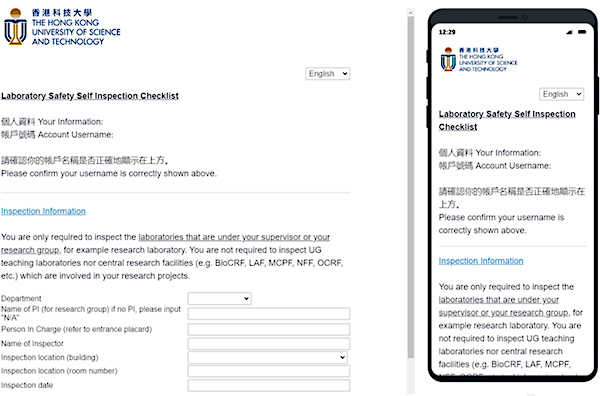Lab Safety
Qualtrics Laboratory Self-Inspection Checklist
HSEO strives to help research teams to create a safer, healthier and more environmentally friendly laboratory environment.
Later In June, Principal Investigators (PIs) and supervisors can look forward to a newly designed laboratory self-inspection checklist to assist them in monitoring their research safety in a more proactive way. This new e-tool can also assist PIs and supervisors to compile a record of their research group's safety performance in a convenient way.


VPRD has recently announced in a new issue of RD Connect, a new requirement of a Completion Report for research projects that have gone through the Committee on Research Practices (CRP) Ethics and Safety Review. This requirement is also incorporated in Clause 5.3 of the Research Compliance Review Procedures. Researchers are expected to duly close their approved ethics protocols by filling in a new Completion Report section in Tick@Lab, and for projects with safety approval, HSEO will help researchers compile a Safety Completion Report. The records of conducting laboratory self-inspection using the new e-tool will become an essential part of the research group's self-initiated safety performance.
The first round of self-inspection will kick-off in late June. PIs and supervisors with ongoing funded projects involving hazardous agents will receive a notification email with a link to the Qualtrics checklist. The inspection frequency is set to be at least two times a year, in every May and November. PIs and supervisors, or a delegated team member, should inspect each laboratory under their control, based on the checklist, within the given time frame. In the next phase (tentatively Q2 2024), the checklist will be made available to all laboratory users.
The checklist is developed by HSEO. It covers common laboratory safety concerns, from general safety to specific hazards such as biological, chemical, laser and radiation, etc. It is easy to use and can be accessed from a computer, mobile device or tablet (iPhone, iPad, Tablet, etc.). In addition, it is available in both English and Chinese languages. With its user-friendly interface and comprehensive coverage, this e-tool will help remind researchers about important hazard control measures and enable them to efficiently self-monitor laboratory safety. We hope all researchers will make good use of this new tool and help create a safer research environment.
